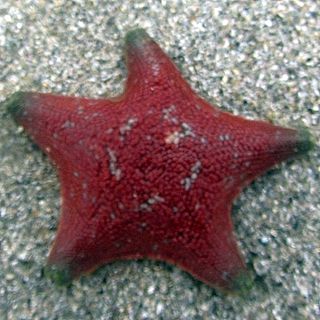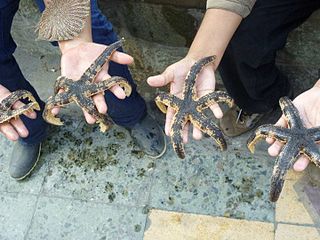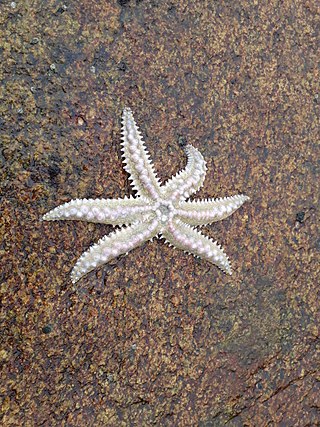
Starfish or sea stars are star-shaped echinoderms belonging to the class Asteroidea. Common usage frequently finds these names being also applied to ophiuroids, which are correctly referred to as brittle stars or basket stars. Starfish are also known as asteroids due to being in the class Asteroidea. About 1,900 species of starfish live on the seabed in all the world's oceans, from warm, tropical zones to frigid, polar regions. They are found from the intertidal zone down to abyssal depths, at 6,000 m (20,000 ft) below the surface.

Protoreaster nodosus, commonly known as the horned sea star or chocolate chip sea star, is a species of sea star found in the warm, shallow waters of the Indo-Pacific region. They are sometimes seen in the marine aquarium trade or dried and sold as curios.

Mediaster aequalis is a species of sea star in the family Goniasteridae. It is native to the west coast of North America, ranging from Alaska to California. It is found in various habitats including beaches during very low tides, and at depths down to about 500 m (1,600 ft). Also known as the vermilion sea star, it is the type species of the genus Mediaster and was first described in 1857 by the American zoologist William Stimpson.

Culcita is a genus of sea stars. They are found in tropical waters. Some are kept in home aquariums.

The Forcipulatida are an order of sea stars, containing three families and 49 genera.

Patiria miniata, the bat star, sea bat, webbed star, or broad-disk star, is a species of sea star in the family Asterinidae. It typically has five arms, with the center disk of the animal being much wider than the stubby arms are in length. Although the bat star usually has five arms, it sometimes has as many as nine. Bat stars occur in many colors, including green, purple, red, orange, yellow and brown, either mottled or solid. The bat star gets its name from the webbing between its arms, which is said to resemble a bat's wings.

Heliaster solaris commonly known as 24-rayed sunstar is a possibly extinct sea star which was known from the waters near Española Island in the Galápagos Islands. The species was endemic to the Galápagos Island group, where it appears to have been strictly restricted to the waters around the Isla Espanola.

Pentaceraster cumingi, sometimes known as the Panamic cushion star, Cortez starfish or knobby star, is a species of starfish in the family Oreasteridae. It is found in warmer parts of the East Pacific and in Hawaii. In Panama this species has been collected from the Pearl Islands, Gulf of Panama, and off Coiba Island, Gulf of Chiriqui. It reaches a diameter of about 30 cm (12 in).

Sea star wasting disease or starfish wasting syndrome is a disease of starfish and several other echinoderms that appears sporadically, causing mass mortality of those affected. There are approximately 40 species of sea stars that have been affected by this disease. At least 20 of these species were on the Northwestern coast of Mexico to Alaska. The disease seems to be associated with increased water temperatures in some locales, but not others. It starts with the emergence of lesions, followed by body fragmentation and death. In 2014 it was suggested that the disease is associated with a single-stranded DNA virus now known as the sea star-associated densovirus (SSaDV). However, this hypothesis was refuted by recent research in 2018 and 2020. Sea star wasting disease is still not fully understood.

Heliaster kubiniji is a species of starfish in the order Forcipulatida. It is commonly known as the gulf sun star, the common sun star or estrella de mar de golfo and it occurs in the intertidal zone of the Pacific coast of California, Mexico and Nicaragua.

The Zoroasteridae are one of three families of Asteroidea in the order Forcipulatida. It contains seven living genera and one extinct genus.

Heliaster microbrachius is a species of Asteroidea in the family Heliasteridae.

Patiria chilensis is a species of starfish in the family Asterinidae. It is found in the southeastern Pacific Ocean along the coasts of South America. It is a broadly pentagonal, cushion-like starfish with five short arms.

Luidia magellanica is a species of starfish in the family Luidiidae. It is found in the southeastern Pacific Ocean on the coast of South America.

Meyenaster is a genus of starfish in the family Asteriidae. It is a monotypic genus and the only species is Meyenaster gelatinosus which was first described by the Prussian botanist and zoologist Franz Julius Ferdinand Meyen in 1834. It is found in the southeastern Pacific Ocean on the coasts of South America.

Heliaster helianthus, the sun star, is a species of Asteroidea (starfish) in the family Heliasteridae. It is found in shallow water rocky habitats and in the kelp forests off the Pacific coast of Ecuador, Peru and Chile.

Tetrapygus is a genus of sea urchins in the family Arbaciidae. It is a monotypic genus and the only species is Tetrapygus niger which was first described by the Chilean naturalist Juan Ignacio Molina in 1782. It is found in the southeastern Pacific Ocean on the coasts of South America.
Asterias versicolor is a species of starfish native to the southern coasts of Japan southwards to the South China Sea.
Maureen Elizabeth Downey was an American zoologist who worked for three decades at the Smithsonian National Museum of Natural History. Known as "The Starfish Lady," she was an authority on sea stars and other echinoderms, co-founding the International Echinoderm Conference in 1972. Among her discoveries is Midgardia xandaros, the world's largest starfish.
Helen Elizabeth Shearburn Rotman was a New Zealand expert on echinoderms, specifically starfish.






















